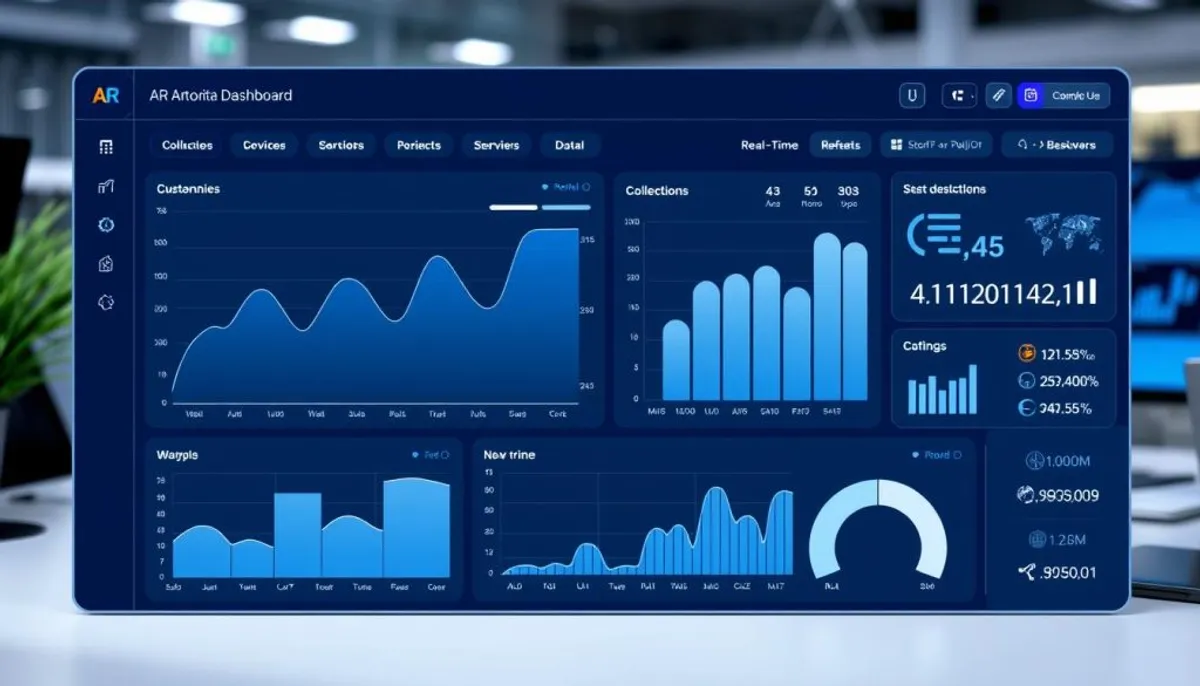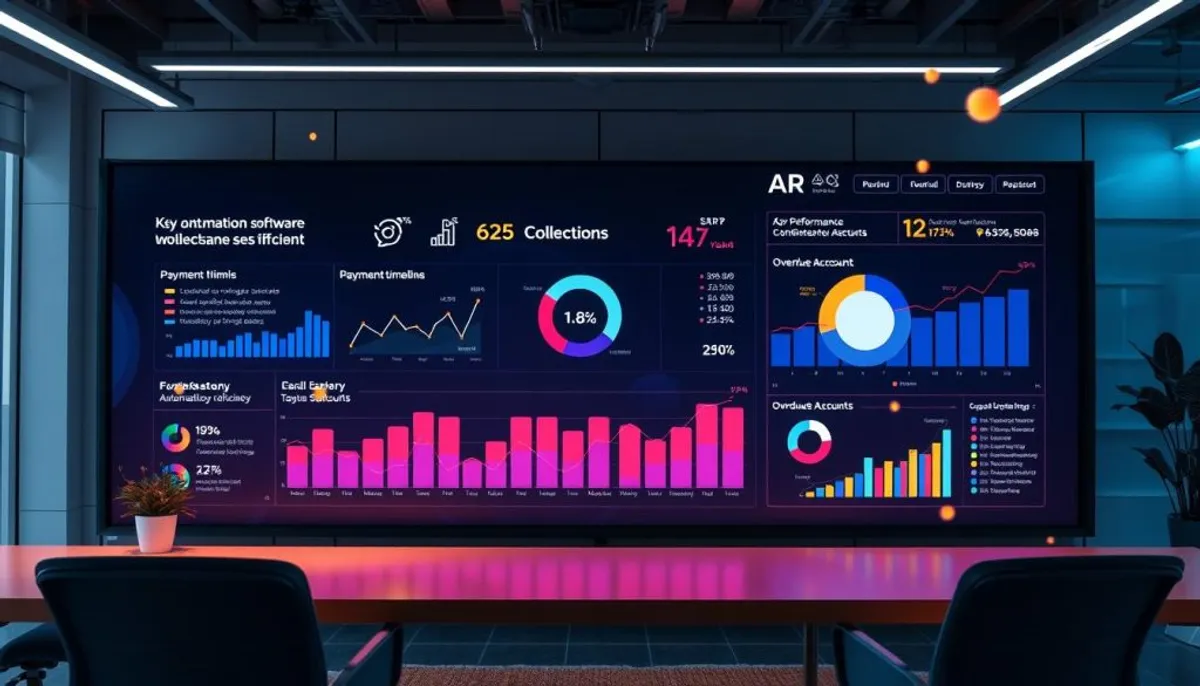In today’s fast-paced business world, ar automation software is revolutionizing how companies manage their accounts receivable. This intelligent automation solution is a game-changer for businesses looking to streamline their collections process and boost efficiency. By leveraging robotic process automation, companies can say goodbye to time-consuming manual tasks and hello to a more streamlined approach.
AR automation software offers a range of benefits, from reducing errors to improving cash flow. It’s not just about managing outflows; it’s about optimizing working capital and nurturing customer relationships. With platforms like Centime, businesses can automate reminders, escalate issues, and collect payments from overdue customers without breaking a sweat.

The impact of ar automation software is significant. Companies using these solutions report 50% less time managing receivables and 25% faster payments. They also see a 30% reduction in past-due invoices and boast a 95% customer satisfaction rate. These numbers speak volumes about the power of intelligent automation in transforming accounts receivable processes.
Key Takeaways
- AR automation software streamlines collections and improves efficiency
- Robotic process automation reduces manual tasks and errors
- Intelligent automation optimizes working capital management
- Companies report faster payments and fewer past-due invoices
- Customer satisfaction rates improve with AR automation
Understanding AR Automation Software and Its Impact on Business
AR automation software revolutionizes the management of accounts receivable for businesses. It simplifies invoicing, payment tracking, and financial reporting. This innovation is crucial for modern enterprises aiming for enhanced efficiency and precision in their financial operations.
What is Accounts Receivable Automation
AR automation employs workflow automation to manage tasks such as invoice generation and payment reminders. It is a pivotal element of business process automation, diminishing manual data entry and expediting invoice processing. This transition to digital processes signifies a substantial advancement in financial management.
The Evolution from Manual to Automated Processes
The shift from manual to automated AR processes has been transformative. Automation tools now undertake tasks that previously demanded extensive human labor. This transformation has resulted in quicker invoice processing, fewer errors, and continuous monitoring of AR activities.
Key Benefits for Modern Businesses
AR automation offers significant benefits to businesses:
- Enhanced cash flow management
- Faster invoice processing
- Reduced Days Sales Outstanding (DSO)
- Improved accuracy in financial records
- Better visibility of AR processes
| Benefit | Impact |
|---|---|
| Time Savings | 41-60 hours saved per week on unpaid invoices |
| Error Reduction | Minimized manual data entry errors |
| Cash Flow | Faster payments and reduced DSO |
| Customer Satisfaction | Improved with timely reminders and multiple payment options |
By adopting these automation tools, businesses can concentrate on expansion and strategy formulation, rather than mundane financial duties. This leads to a more efficient, precise, and lucrative operation.
The Critical Components of AR Automation Software
AR automation software is transforming the way businesses manage their accounts receivable. These platforms combine essential elements to streamline financial operations. This integration is crucial for enhancing efficiency and accuracy.
Invoice Generation and Distribution
Modern rpa software automates the creation and dispatch of invoices. This process accelerates billing cycles and minimizes errors. Digital invoicing enables businesses to send bills instantly, reducing paper waste and postage expenses.
Payment Processing and Reconciliation
Cognitive automation in AR software ensures seamless payment processing. It accurately matches incoming payments with outstanding invoices, updating records in real-time. This efficient reconciliation significantly enhances cash flow management.
Collections Management Tools
AR automation platforms feature advanced tools for managing collections. These tools automatically send reminders, prioritize follow-ups, and track customer interactions. As a result, businesses can collect payments more swiftly and effectively.
Analytics and Reporting Features
Access to data-driven insights is vital for making informed financial decisions. AR automation software offers detailed reports on payment trends, customer behavior, and AR performance. These insights enable businesses to identify issues promptly and make strategic decisions.
| Component | Benefit | Impact |
|---|---|---|
| Invoice Automation | 87% faster processing | Quicker billing cycles |
| Payment Processing | 23-day reduction in payment time | Improved cash flow |
| Collections Tools | 49% better collection rates | Reduced late payments |
| Analytics | 27% use of advanced analytics | Data-driven strategies |
By integrating these components, AR automation software revolutionizes financial processes. It boosts efficiency and accuracy, benefiting businesses across the board.
How AR Automation Software Transforms Collections
AR automation software is transforming the collections process, introducing efficiency and precision to businesses. It addresses critical challenges in accounts receivable management, enhancing operations and financial health.
Streamlining Payment Workflows
Automation solutions streamline invoice generation and delivery. They automatically create invoices and send them electronically, accelerating the process. This system offers diverse payment options, including credit cards, ACH transfers, and EFTs, facilitating customer payments.

Reducing Manual Errors and Inefficiencies
AR automation software dramatically reduces human errors. It standardizes data entry, enhancing data accuracy. This leads to significant efficiency gains, liberating the AR team from mundane tasks. In fact, it can result in cost savings exceeding 70% in invoicing expenses.
Improving Cash Flow Management
Intelligent automation accelerates the Order-to-Cash cycle, shortening the time from sale to payment receipt. It sends automated payment reminders and personalized notifications, reducing late payments. The software also provides real-time data access, facilitating strategic decision-making.
| Metric | Impact of AR Automation |
|---|---|
| Cost Savings | Up to 70% reduction in invoicing expenses |
| Manual Data Entry | 100% elimination of lockbox data capture fees |
| Strategic Focus | 75% of finance leaders report increased bandwidth for strategic initiatives |
| Talent Retention | 73% improvement in attracting and retaining finance talent |
By transforming collections, AR automation software empowers businesses to optimize their financial processes, enhance customer satisfaction, and focus on strategic growth initiatives.
Key Features of Modern AR Automation Platforms
Modern AR automation platforms introduce a suite of features designed to streamline collections and enhance efficiency. These tools transform traditional accounts receivable tasks into efficient digital workflows. This transformation is pivotal for businesses aiming to optimize their financial operations.
Automated email systems handle dunning and escalations, eliminating the need for manual follow-ups. Cash application features expedite the matching of invoices to payments, significantly reducing errors. Credit monitoring tools further aid in managing customer accounts effectively.
Self-service payer portals empower customers, while dispute management features ensure swift resolution of issues. Comprehensive reporting provides real-time insights into financial health, enabling businesses to make informed decisions promptly.
- Automated email reminders
- Cash application matching
- Credit monitoring
- Self-service portals
- Dispute management
- Analytics dashboard
These features collectively create a seamless AR experience. By integrating these tools, businesses can significantly reduce time spent on manual tasks, lower costs, and improve cash flow. Platforms like InvoiceSherpa, Chaser, and Bill.com offer customized solutions to meet diverse business needs.
With the right automation tools, CFOs can redirect their focus from mundane tasks to strategic planning. This technology not only accelerates payment schedules but also strengthens customer relationships through personalized, efficient interactions.
Implementing AR Automation: Best Practices and Strategies
Adopting accounts receivable (AR) automation is transformative for enterprises aiming to refine their collections workflow. Through the application of business process automation and cognitive automation, firms can notably enhance their fiscal operations.
Integration with Existing Systems
Ensuring the smooth integration of AR automation software with current systems is paramount. Organizations can witness a 33% enhancement in credit controller coverage and a more than 50% surge in team productivity by adeptly integrating their technological infrastructure. This integration facilitates the seamless exchange of data between AR automation tools and other fiscal systems.
Staff Training and Adoption
The successful deployment of AR automation hinges on thorough staff training. Employees must grasp the functionality of RPA software to fully exploit its advantages. Training should encompass:
- Utilizing new AR automation tools
- Comprehending automated workflows
- Interpreting analytics and reports
Setting Up Automated Workflows
Establishing efficient automated workflows is essential for optimizing the AR process. This entails:
- Customizing email templates for invoice reminders
- Implementing a robust dunning mechanism for defaulted payments
- Creating an AR dashboard for thorough performance tracking
By adopting these methodologies, businesses can diminish manual errors, enhance cash flow management, and expedite payment processing by 20-30%.
Measuring Success: KPIs and Performance Metrics
AR automation software empowers businesses to monitor key performance indicators (KPIs) for their collections process success. These metrics offer crucial insights into the efficiency and effectiveness of accounts receivable management.
Days Sales Outstanding (DSO)
DSO gauges the average time to collect payment post-sale. A reduced DSO signifies quicker collection and enhanced cash flow. The formula for DSO is:
(Accounts Receivable ÷ Total Credit Sales) x Number of Days
Inconspicuous Inc. recorded a DSO of 45.2 days in February, illustrating their average collection duration post-sale.
Collection Effectiveness Index (CEI)
CEI assesses a company’s payment collection prowess relative to total receivables. The formula is:
(Beginning A/R + Monthly Credit Sales – Total Ending A/R) x 100 / (Beginning A/R + Monthly Credit Sales – Current Ending A/R)
Inconspicuous Inc. achieved a CEI of 58.8% in February, reflecting their collection efficiency.
AR Turnover Ratio
This ratio delineates the speed at which receivables are converted into cash. It’s calculated as:
Net Credit Sales ÷ Average Accounts Receivable
Inconspicuous Inc. boasted an AR Turnover Ratio of 11.2, showcasing the frequency of receivables conversion into cash within the previous year.

| KPI | Formula | Inconspicuous Inc. Example |
|---|---|---|
| Days Sales Outstanding (DSO) | (Accounts Receivable ÷ Total Credit Sales) x Number of Days | 45.2 days |
| Collection Effectiveness Index (CEI) | (Beginning A/R + Monthly Credit Sales – Total Ending A/R) x 100 / (Beginning A/R + Monthly Credit Sales – Current Ending A/R) | 58.8% |
| AR Turnover Ratio | Net Credit Sales ÷ Average Accounts Receivable | 11.2 |
By harnessing automation solutions, businesses can effortlessly track these KPIs, gaining valuable insights to refine their collections process. AR automation software often comes equipped with analytics tools, facilitating easier performance monitoring and data-driven decision-making.
Security and Compliance in AR Automation
AR automation software introduces advanced security and compliance features to financial operations. These tools, known for their intelligent automation, offer bank-level security. They hold PCI SAQ A and SOC 1 certifications, ensuring the highest level of data protection. By integrating robotic process automation, businesses can drastically lower fraud risks and improve financial process security.
Automated systems enhance audit trails and documentation, supporting compliance efforts. This is vital, as 77% of AR teams face delays in keeping up with invoices due to inefficiencies. Automation tools help companies overcome these challenges while meeting industry regulations and standards.
- Reduction in manual errors, leading to less time and money spent on resolving discrepancies
- Implementation of strict controls and approval workflows
- Real-time insights into financial position and outstanding invoices
- Seamless scaling of financial operations with business growth
A study with Wakefield showed that inefficient AR processes cause teams to manually resolve challenges on nearly $3.7 million worth of invoices monthly for a typical mid- to upper-mid sized company. AR automation software tackles these problems while ensuring the highest security and compliance standards.
| Security Feature | Compliance Benefit |
|---|---|
| Bank-level encryption | Enhanced data protection |
| Automated audit trails | Improved regulatory compliance |
| Strict access controls | Reduced risk of internal fraud |
| Real-time monitoring | Faster incident response |
The Future of AR Automation Technology
AR automation technology is rapidly advancing, reshaping the landscape of accounts receivable processes in businesses. The trajectory of this evolution points towards sophisticated systems. These will harness the power of artificial intelligence, machine learning, and predictive analytics.
Artificial Intelligence and Machine Learning
AI-driven AR automation software is poised to transform workflow automation. It promises to decrease days sales outstanding (DSO) and enhance cash flow management. These systems excel in matching payments to invoices, reducing errors and saving time. This level of cognitive automation significantly boosts efficiency and accuracy in transaction processing.
Predictive Analytics
The inclusion of predictive analytics in AR automation marks a significant shift in business process automation. It enables proactive risk management and more informed financial decisions. AI-powered predictive tools forecast remittance patterns, allowing teams to anticipate late or missed payments. This capability optimizes working capital and overall financial health.
Integration Capabilities
Future AR automation platforms will seamlessly integrate with existing systems. This integration facilitates real-time data analysis and swift decision-making. Automated account classification will prioritize collections based on payer types, streamlining the process. These advancements in cognitive automation will lead to improved customer satisfaction, reduced bad debt, and accelerated receivables cycles.
Conclusion
AR automation software has transformed the management of accounts receivable processes for businesses. By utilizing rpa software and automation platforms, companies can notably enhance their cash flow and operational efficiency. These solutions tackle common hurdles like slow collections cycles, lack of visibility, and inefficient resource allocation.
The effects of AR automation are clear. It speeds up collections cycles, cuts down on manual errors, and offers crucial insights into payment trends. For example, automation in financial services has resulted in quicker payment cycles and enhanced accuracy in tasks like invoice generation. This is greatly advantageous in sectors such as retail, e-commerce, and manufacturing, where high transaction volumes are prevalent.
The future of AR automation looks promising. The integration of AI, RPA, and blockchain technologies is set to create even more intelligent and flexible systems. Cloud-based solutions are making these advanced tools more accessible to small and medium-sized enterprises. As businesses increasingly adopt these innovative automation platforms, they will be better positioned to handle the complexities of modern financial management.
RelatedRelated articles



